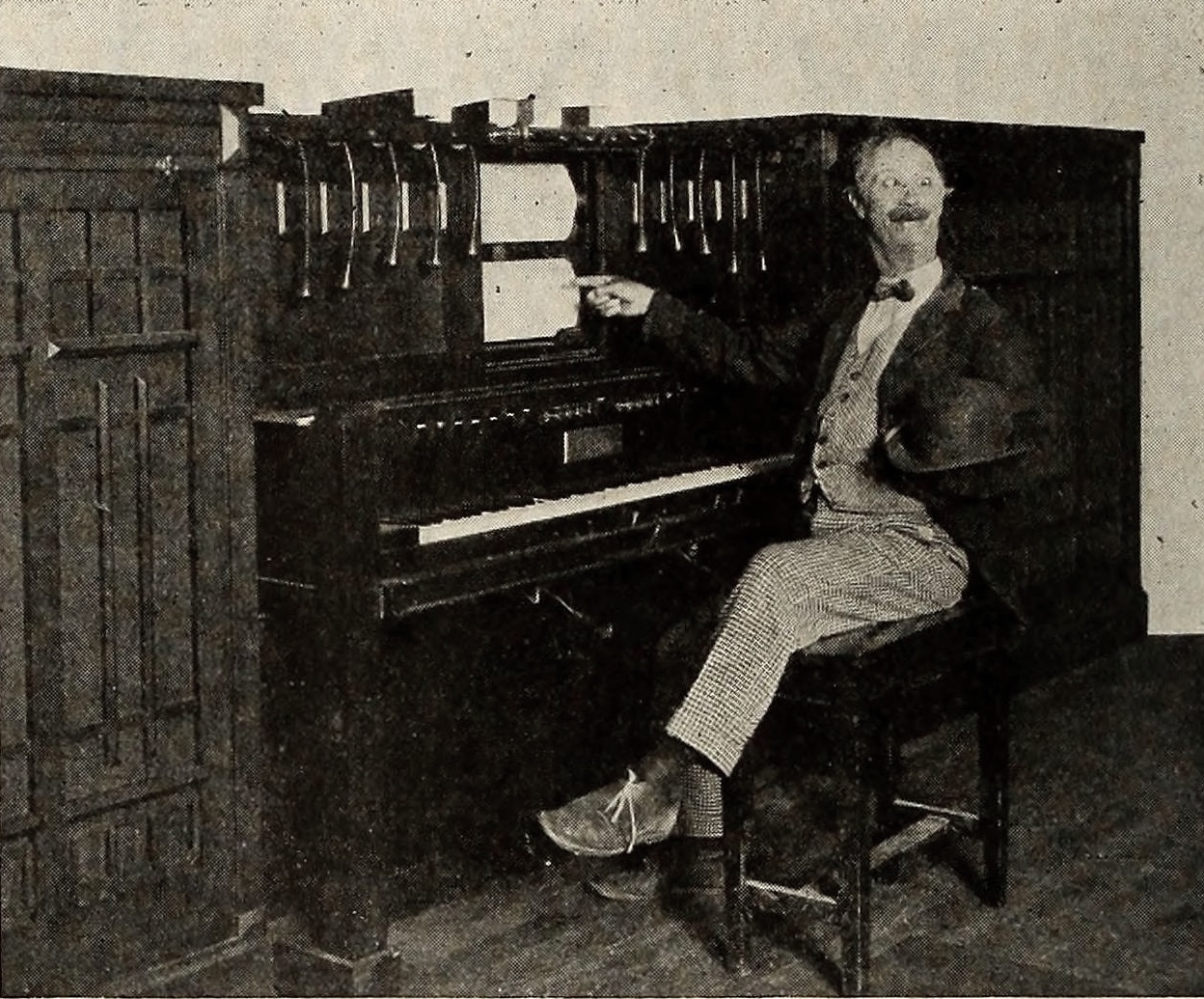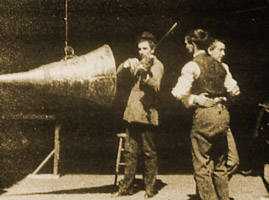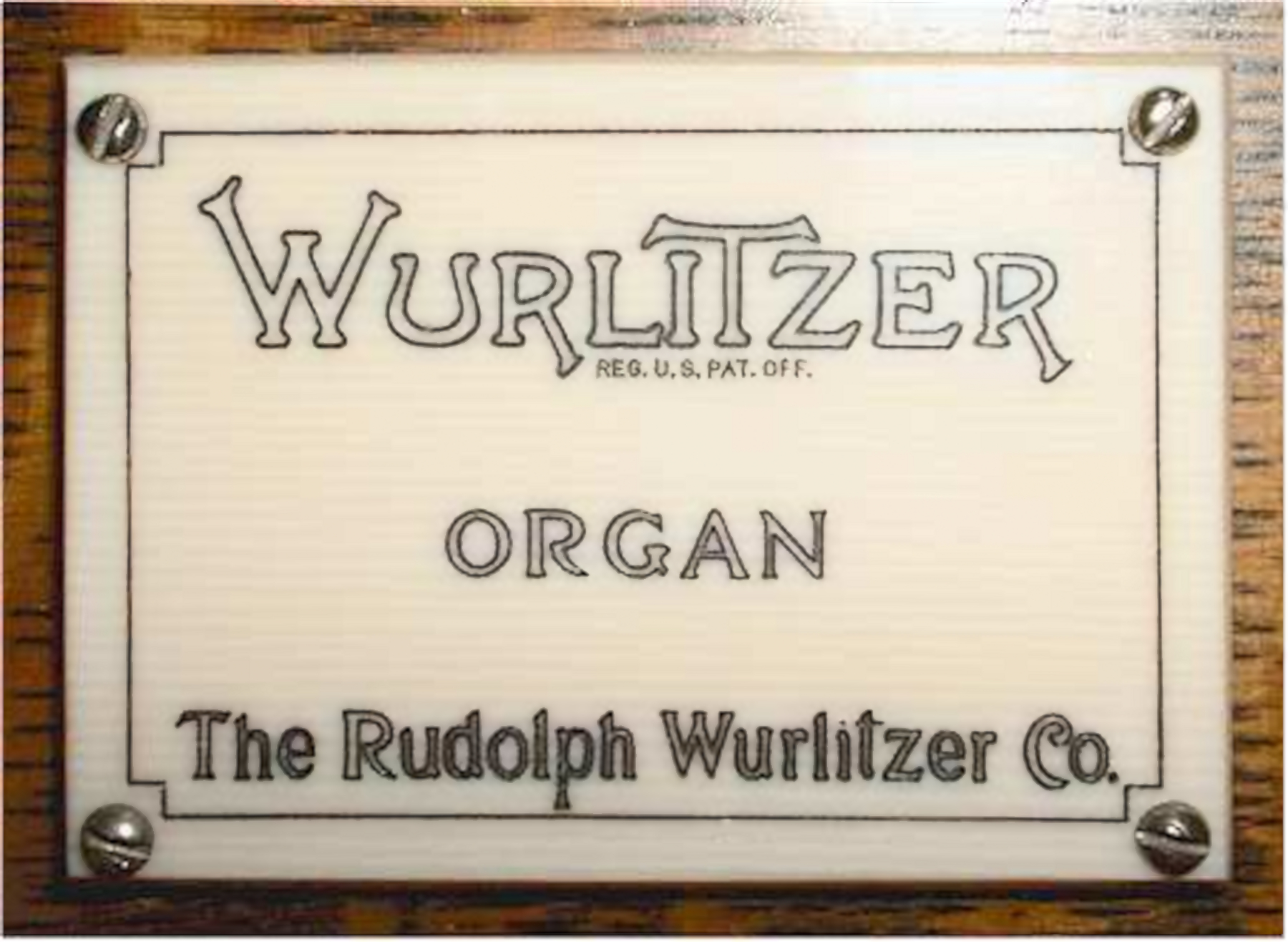|
Photoplayer
The photoplayer is an automatic mechanical orchestra used by movie theatres to produce photoplay music to accompany silent films. Operation The central instruments in a photo player were a piano and percussion; some machines also added pipe organs and methods for manually creating sound effects. Like a player piano, the photo player played music automatically by reading piano rolls (rolls of paper with perforations), but the photo player could hold two rolls: one that would play while the other was prepared. Common sound effects included gunshots, bells and drums, which were generated by pulling chains called "cow-tails". Some photo players feature electric sound effects, such as sirens, automobile horns, and other oddities. A photo player operator had to load the paper rolls, start the machine and add the manual sound effects and percussion using the cow-tails. History Approximately 8,000 to 10,000 photoplayers were produced during the boom era of silent films, between 1910 ... [...More Info...] [...Related Items...] OR: [Wikipedia] [Google] [Baidu] |
Barton Organ Company
The Bartola Musical Instrument Company of Oshkosh, Wisconsin, United States, was a producer of theatre organ, theater pipe organs during the age of silent movies. History The company was founded in 1918 by Dan Barton, who was from Amherst, Wisconsin. The sixth largest builder of theater instruments in the nation, Bartola focused almost exclusively on the Midwestern United States, Midwest market. Barton later recalled, "We decided to work only a limited territory so we could give prompt service to all our installations. [This territory included] Wisconsin, Illinois, Michigan, Iowa, Indiana and Ohio. No installation was more than an overnight sleeper ride from Chicago." For this reason, the instruments were almost unknown outside of this relatively small area until later years, long after manufacture had ceased, when many were moved from their original homes into venues around the United States. The company built about 250 Theatre organ, theater organs from 1918 to 1931. Bar ... [...More Info...] [...Related Items...] OR: [Wikipedia] [Google] [Baidu] |
American Fotoplayer
The American Fotoplayer is a type of photoplayer developed by the American Photo Player Co. between the years of 1912 and 1925. The Fotoplayer is a type of player piano specifically developed to provide music and special sound effects for silent movies. History Before movies had sound, it was discovered that playing background music during a film could aid in developing a particular mood for a certain scene. Initially, small theatres would use player pianos to produce music automatically from piano roll A piano roll is a music storage medium used to operate a player piano, piano player or reproducing piano. Piano rolls, like other music rolls, are continuous rolls of paper with holes punched into them. These perforations represent note contro ...s. After some time, some of these pianos were extended in size with pipe organs and sound effects inserted into large cabinets connected to the sides of the piano. The user of this new contraption could then create multiple sounds to m ... [...More Info...] [...Related Items...] OR: [Wikipedia] [Google] [Baidu] |
The American Fotoplayer
The American Fotoplayer is a type of photoplayer developed by the American Photo Player Co. between the years of 1912 and 1925. The Fotoplayer is a type of player piano specifically developed to provide music and special sound effects for silent movies. History Before movies had sound, it was discovered that playing background music during a film could aid in developing a particular mood for a certain scene. Initially, small theatres would use player pianos to produce music automatically from piano roll A piano roll is a music storage medium used to operate a player piano, piano player or reproducing piano. Piano rolls, like other music rolls, are continuous rolls of paper with holes punched into them. These perforations represent note contro ...s. After some time, some of these pianos were extended in size with pipe organs and sound effects inserted into large cabinets connected to the sides of the piano. The user of this new contraption could then create multiple sounds to ... [...More Info...] [...Related Items...] OR: [Wikipedia] [Google] [Baidu] |
Sound Effects
A sound effect (or audio effect) is an artificially created or enhanced sound, or sound process used to emphasize artistic or other content of films, television shows, live performance, animation, video games, music, or other media. In motion picture and television production, a sound effect is a sound recorded and presented to make a specific storytelling or creative point ''without'' the use of dialogue or music. Traditionally, in the twentieth century, they were created with Foley (filmmaking), Foley. The term often refers to a process applied to a recording, without necessarily referring to the recording itself. In professional motion picture and television production, dialogue, music, and sound effects recordings are treated as separate elements. Dialogue and music recordings are never referred to as sound effects, even though the processes applied to such as reverberation or flanging effects, often are called ''sound effects''. This area and sound design have been s ... [...More Info...] [...Related Items...] OR: [Wikipedia] [Google] [Baidu] |
Pullchain
A pullstring (pull string, pull-string), pullcord (pull cord, pull-cord), or pullchain (pull-chain, pull chain) is a string, cord, or chain wound on a spring-loaded spindle that engages a mechanism when it is pulled. It is most commonly used in toys and motorized equipment. More generally and commonly, a pullstring can be any type of string, cord, rope, or chain, attached to an object in some way used to pull or mechanically manipulate part of it. Toys Perhaps the simplest pullstring toy is the yo-yo (c. 460 BCE). The jumping jack is a more complicated animated puppet paper doll that uses a pullstring to move its arms and legs up and down. Trompos and some spinning tops use a string that is wound around the top and then pulled to make it spin. More recent toys include dolls, such as Chatty Cathy (1959), Charmin' Chatty (1963), Talking Tamu (1970), Look Around Crissy (1972), Sky Dancers (1994), and Sheriff Woody (from the ''Toy Story'' franchise), that have a pullstring ... [...More Info...] [...Related Items...] OR: [Wikipedia] [Google] [Baidu] |
Theatre Organs
A theatre organ (also known as a theater organ, or, especially in the United Kingdom, a cinema organ) is a type of pipe organ developed to accompany silent films from the 1900s to the 1920s. Theatre organs have horseshoe-shaped arrangements of stop tabs (tongue-shaped switches) above and around the instrument's keyboards on their consoles. Theatre organ consoles were typically decorated with brightly colored stop tabs, with built-in console lighting. Organs in the UK had a common feature: large translucent surrounds extending from both sides of the console, with internal colored lighting. Theatre organs began to be installed in other venues, such as civic auditoriums, sports arenas, private residences, and churches. Though there are few original instruments, hundreds of theatre pipe organs are installed in public venues throughout the world today, while many more exist in private residences. History Originally, films were accompanied by pit orchestras in larger houses, and pi ... [...More Info...] [...Related Items...] OR: [Wikipedia] [Google] [Baidu] |
Sound Films
A sound film is a Film, motion picture with synchronization, synchronized sound, or sound technologically coupled to image, as opposed to a silent film. The first known public exhibition of projected sound films took place in Paris in 1900, but decades passed before sound motion pictures became commercially practical. Reliable synchronization was difficult to achieve with the early sound-on-disc systems, and amplification and recording quality were also inadequate. Innovations in sound-on-film led to the first commercial screening of Short film, short motion pictures using the technology, which took place in 1923. Before sound-on-film technology became viable, soundtracks for films were commonly played live with organs or pianos. The primary steps in the commercialization of sound cinema were taken in the mid-to-late 1920s. At first, the sound films which included synchronized dialogue, known as "talking pictures", or "talkies", were exclusively shorts. The earliest feature fil ... [...More Info...] [...Related Items...] OR: [Wikipedia] [Google] [Baidu] |
Wurlitzer
The Rudolph Wurlitzer Company, usually referred to as simply Wurlitzer, is an American company started in Cincinnati in 1853 by German immigrant (Franz) Rudolph Wurlitzer. The company initially imported stringed, woodwind and brass instruments from Germany for resale in the United States. Wurlitzer enjoyed initial success, largely due to defense contracts to provide musical instruments to the U.S. military. In 1880, the company began manufacturing pianos and eventually relocated to North Tonawanda, New York. It quickly expanded to make fairground organ, band organs, orchestrions, player pianos and pipe organs, pipe or theatre organs popular in theatres during the days of silent movies. Wurlitzer also operated a chain of retail stores where the company's products were sold. As technology evolved, Wurlitzer began producing Wurlitzer electric piano, electric pianos, electronic organs and jukeboxes, and it eventually became known more for jukeboxes and vending machines, which are s ... [...More Info...] [...Related Items...] OR: [Wikipedia] [Google] [Baidu] |
Seeburg Corporation
Seeburg was an American design and manufacturing company of automated musical equipment, such as orchestrions, jukeboxes, and vending equipment. Founded in 1902, its first products were Orchestrions and automatic pianos but after the arrival of gramophone records, the company developed a series of "coin-operated phonographs." Before it began manufacturing its signature suite of jukebox products, Seeburg was considered to be one of the "big four" of the top coin-operated phonograph companies alongside AMI, Wurlitzer, and Rock-Ola. At the height of jukebox popularity, Seeburg machines were synonymous with the technology and a major quotidian brand of American teenage life. The company went out of business after being sold to Stern Electronics in 1982. History Automated musical equipment, such as coin-operated phonographs and orchestrions, was manufactured under the J.P. Seeburg and Company name for most of its early years. Until 1956, the company was family-owned. The company ... [...More Info...] [...Related Items...] OR: [Wikipedia] [Google] [Baidu] |
Chicago
Chicago is the List of municipalities in Illinois, most populous city in the U.S. state of Illinois and in the Midwestern United States. With a population of 2,746,388, as of the 2020 United States census, 2020 census, it is the List of United States cities by population, third-most populous city in the United States after New York City and Los Angeles. As the county seat, seat of Cook County, Illinois, Cook County, the List of the most populous counties in the United States, second-most populous county in the U.S., Chicago is the center of the Chicago metropolitan area, often colloquially called "Chicagoland" and home to 9.6 million residents. Located on the shore of Lake Michigan, Chicago was incorporated as a city in 1837 near a Chicago Portage, portage between the Great Lakes and the Mississippi River, Mississippi River watershed. It grew rapidly in the mid-19th century. In 1871, the Great Chicago Fire destroyed several square miles and left more than 100,000 homeless, but ... [...More Info...] [...Related Items...] OR: [Wikipedia] [Google] [Baidu] |
Piano Rolls
A piano roll is a music storage medium used to operate a player piano, piano player or reproducing piano. Piano rolls, like other music rolls, are continuous rolls of paper with holes punched into them. These perforations represent note control data. The roll moves over a reading system known as a tracker bar; the playing cycle for each musical note is triggered when a perforation crosses the bar. Piano rolls have been in continuous production since at least 1896, and are still being manufactured today; QRS Records, QRS Music offers 45,000 titles with "new titles being added on a regular basis", although they are no longer mass-produced. MIDI files have generally supplanted piano rolls in storing and playing back performance data, accomplishing digitally and electronically what piano rolls do mechanically. MIDI editing software often features the ability to represent the music graphically as a piano roll. The first paper rolls were used commercially by Welte-Mignon, Welte & Sons ... [...More Info...] [...Related Items...] OR: [Wikipedia] [Google] [Baidu] |






